Título
3D Bioprinted Hydroxyapatite or Graphene Oxide Containing Nanocellulose-Based Scaffolds for Bone RegenerationAutor-a
Autor-a (de otra institución)
Fecha de publicación
2022Otras instituciones
Universidad del País Vasco/Euskal Herriko Unibertsitatea (UPV/EHU)Versión
Version publicadaTipo de documento
ArtículoArtículoIdioma
InglésDerechos
© 2022 The AuthorsAcceso
Acceso abiertoVersión de la editorial
https://doi.org/10.1002/mabi.202200236Publicado en
Macromolecular Bioscience 2200236. August, 2022Editorial
WileyPalabras clave
3D bioprinting
bioinks
bone
graphene oxide ... [+]
bioinks
bone
graphene oxide ... [+]
3D bioprinting
bioinks
bone
graphene oxide
hydroxyapatite
tissue engineering [-]
bioinks
bone
graphene oxide
hydroxyapatite
tissue engineering [-]
Resumen
Bone tissue is usually damaged after big traumas, tumors, and increasing aging-related diseases such as osteoporosis and osteoarthritis. Current treatments are based on implanting grafts, which are sh ... [+]
Bone tissue is usually damaged after big traumas, tumors, and increasing aging-related diseases such as osteoporosis and osteoarthritis. Current treatments are based on implanting grafts, which are shown to have several inconveniences. In this regard, tissue engineering through the 3D bioprinting technique has arisen to manufacture structures that would be a feasible therapeutic option for bone regenerative medicine. In this study, nanocellulose–alginate (NC–Alg)-based bioink is improved by adding two different inorganic components such as hydroxyapatite (HAP) and graphene oxide (GO). First, ink rheological properties and biocompatibility are evaluated as well as the influence of the sterilization process on them. Then, scaffolds are characterized. Finally, biological studies of embedded murine D1 mesenchymal stem cells engineered to secrete erythropoietin are performed. Results show that the addition of both HAP and GO prevents NC–Alg ink from viscosity lost in the sterilization process. However, GO is reduced due to short cycle autoclave sterilization, making it incompatible with this ink. In addition, HAP and GO have different influences on scaffold architecture and surface as well as in swelling capacity. Scaffolds mechanics, as well as cell viability and functionality, are promoted by both elements addition. Additionally, GO demonstrates an enhanced bone differentiation capacity. [-]
Sponsorship
Gobierno Vasco-Eusko JaurlaritzaID Proyecto
info:eu-repo/grantAgreement/GV/Ayudas para apoyar las actividades de grupos de investigación del sistema universitario vasco Grupos Consolidados (EHU)/IT907-16/CAPV//Colecciones
- Artículos - Ingeniería [757]
El ítem tiene asociados los siguientes ficheros de licencia:






















